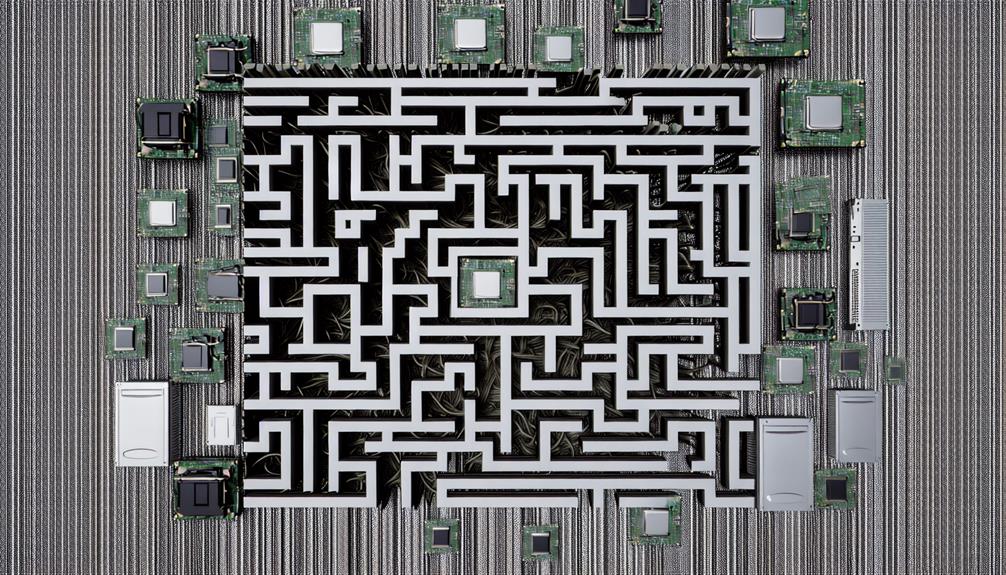Exploring deep learning with intricate data sets involves utilizing specialized techniques and architectural components to guarantee precise and efficient processing. Complex sequences necessitate architectures like 1-D CNNs that employ padding, data partitioning, and global average pooling. Constructing resilient network structures involves utilizing convolutional and pooling layers efficiently. Training choices, such as specifying optimizers and learning rates, and proper sequence length optimization are essential. Comprehensive validation techniques, like cross-validation and metrics like RMSE, guarantee generalizable performance. By following these guidelines, models can effectively manage complex datasets, resulting in enhanced predictive capabilities.
Key Takeaways
- Intricate sequences require specialized architectures like 1-D CNNs, along with techniques like padding, data splitting, and global average pooling.
- Strong network structures, such as those utilizing convolutional and global average pooling layers, are vital for handling intricate datasets.
- Training options like specifying optimizers, learning rates, and leveraging GPU usage enhance model performance while monitoring resource utilization.
- Balancing sequence lengths and ensuring proper optimization are crucial for sequence-to-sequence tasks like machine translation.
- Thorough validation using metrics like RMSE and cross-validation techniques guarantees accurate and generalizable model performance.
Handling Intricate Sequences
When navigating the complexities of deep learning, intricate sequences pose notable challenges because of their varying lengths, multiple channels, and complex patterns. These sequences not only require specialized architectures to effectively process and analyze them but also demand a deep understanding of the data itself.
In this scenario, 1-D convolutional neural networks (CNNs) have emerged as a reliable solution for handling intricate sequences. Techniques such as padding, data splitting, and global average pooling are essential in managing these complex sequences, ensuring that the information is harnessed without losing important details.
The importance of these specialized techniques cannot be overstated, as they greatly impact the performance of deep learning models. By applying these methods, the inherent patterns within the sequences can be effectively captured, leading to enhanced model performance and more accurate predictions.
Therefore, researchers and practitioners must engage with the nuances of intricate sequences to reveal the true potential of deep learning. By doing so, they can develop models that excel in accuracy and efficiency, ultimately driving progress in the field of artificial intelligence.
Building Robust Network Architectures
Designing strong network structures is vital for deep learning to effectively handle intricate datasets. This necessitates the development of formations that can accurately process diverse data formats and mitigate the impact of noise. This resilience is important because deep learning models often struggle with noise and require careful handling of complex data structures.
Neural network architectures play a pivotal role in this by utilizing specialized layers, such as convolutional layers, which enhance feature extraction by processing data in local regions, and global average pooling layers, which aggregate features for efficient information processing.
In building strong network structures, training involves careful consideration of the output layers. These must be designed to predict multiple values effectively. The task complexity and dataset size also greatly influence the resilience of the model, with more intricate models and larger datasets requiring more robust formations.
Training Options and Resource Utilization

Enhancing neural network training involves carefully specifying various training options, including optimizers and learning rates, to guarantee efficient resource utilization and improved model performance. To expedite training, one can leverage GPU usage, which is particularly advantageous when dealing with resource-intensive computations. Additionally, parallel processing capabilities can be utilized to speed up the training process. It is vital to monitor resource utilization during training to ensure peak memory allocation and processing efficiency.
Validating model performance using validation data is essential to prevent overfitting, thereby improving the network's generalization capabilities. Training progress visualization and detailed output control are valuable tools for tracking training efficiency and identifying areas for enhancement. These aspects of training options and resource utilization play a pivotal role in ensuring that complex data sets can be efficiently processed and accurate models can be trained.
Ensuring Sequence Length Optimization
The Mellifluous Harmony of Balanced Sequences: A Key to Avoiding Model Bias
Ensuring sequence length optimization is vital in deep learning to avoid model bias and guarantee efficient training. Deep learning models process sequences of varying lengths to make predictions. Balancing these sequence lengths is essential for preventing bias towards longer sequences and ensuring uniform data processing.
This is especially critical for certain models like recurrent neural networks (RNNs), which process sequences one step at a time. Shorter sequences may need padding to match longer sequences, maintaining consistency in model training. Longer sequences can consume more resources and lead to overfitting, while shorter sequences can limit a model's ability to capture complex patterns.
Proper sequence length optimization enables models to generalize better and results in more accurate predictions. Strategically selecting the sequence length can also accelerate model convergence and enhance model performance.
Optimization of sequence length is particularly important in sequence-to-sequence tasks, such as machine translation and text summarization. Here, models must process input and output sequences of varying lengths, making balanced sequences essential. The task is not just to optimize sequence length but also to strike a balance between Computational resources and model complexity to achieve both efficiency and accuracy.
Validating Model Performance

As deep learning models navigate the complexities of sequence-to-sequence tasks, thorough validation guarantees that their performance is not only accurate but also robust and generalizable.
Validation is a pivotal step in evaluating how well a model generalizes to new, unseen data. By dividing training data into distinct sets, it is possible to assess the model's performance on validation datasets. Metrics such as root mean squared error (RMSE) provide a standardized measure of errors, confirming the model is precise and not overfitting to training data.
Overfitting, where the model memorizes training data instead of capturing underlying patterns, can be detected through validation. Cross-validation techniques further enhance robustness by dividing data into multiple subsets to estimate generalization error.
Careful tuning of hyperparameters is also essential to avoid overfitting and optimize predictive capabilities. Striking a balance between model complexity and simplistic approaches is vital to ensure that the model generalizes well to new, unseen data. Cross-validation guarantees that every data point is utilized in both training and testing, providing a thorough assessment of model performance.
Frequently Asked Questions
How Do You Handle Large Datasets in Deep Learning?
To handle large datasets in deep learning, implement data preprocessing, data augmentation, and mini-batch training. Additionally, leverage transfer learning, regularization techniques, hyperparameter tuning, feature selection, model ensembling, dimensionality reduction, and balanced class handling for optimized performance and efficiency.
Can Neural Networks Handle Complex Data?
Yes, neural networks can handle complex data by leveraging model scalability, data preprocessing, feature engineering, and hyperparameter tuning to mitigate overfitting and guarantee robust performance.
Can Deep Learning Systems Solve Complex Problems?
Deep learning systems can solve complex problems such as image recognition, sentiment analysis, speech recognition, medical diagnosis, and others by autonomously learning hierarchical data representations from diverse big data.
Does Deep Learning Work in Structured Data?
Yes, deep learning effectively processes structured data, facilitating applications such as image recognition, natural language processing, time series analysis, fraud detection, sentiment analysis, customer segmentation, anomaly detection, predictive maintenance, credit risk, and healthcare diagnosis.









